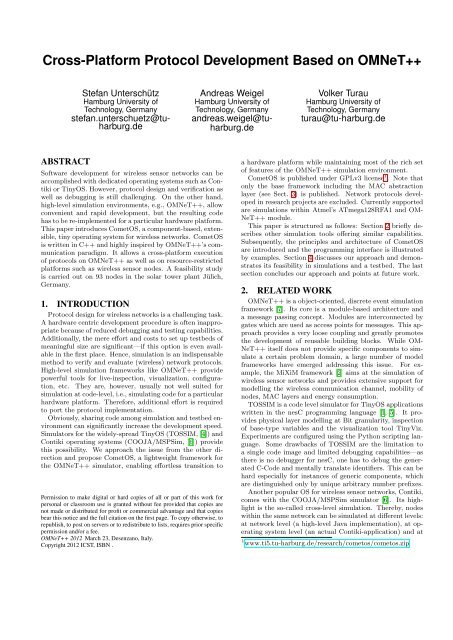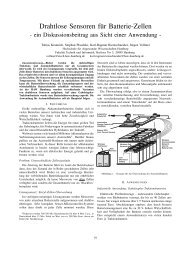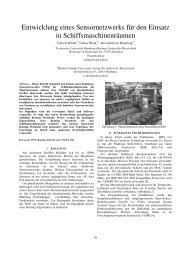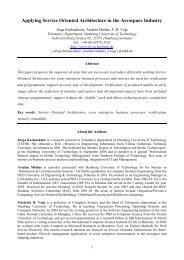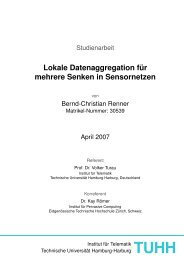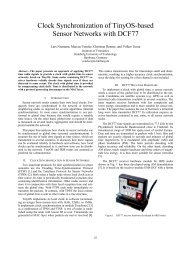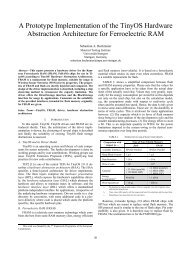Cross-Platform Protocol Development Based on OMNeT++
Cross-Platform Protocol Development Based on OMNeT++
Cross-Platform Protocol Development Based on OMNeT++
You also want an ePaper? Increase the reach of your titles
YUMPU automatically turns print PDFs into web optimized ePapers that Google loves.
<str<strong>on</strong>g>Cross</str<strong>on</strong>g>-<str<strong>on</strong>g>Platform</str<strong>on</strong>g> <str<strong>on</strong>g>Protocol</str<strong>on</strong>g> <str<strong>on</strong>g>Development</str<strong>on</strong>g> <str<strong>on</strong>g>Based</str<strong>on</strong>g> <strong>on</strong> <strong>OMNeT++</strong><br />
ABSTRACT<br />
Stefan Unterschütz<br />
Hamburg University of<br />
Technology, Germany<br />
stefan.unterschuetz@tuharburg.de<br />
Software development for wireless sensor networks can be<br />
accomplished with dedicated operating systems such as C<strong>on</strong>tiki<br />
or TinyOS. However, protocol design and verificati<strong>on</strong> as<br />
well as debugging is still challenging. On the other hand,<br />
high-level simulati<strong>on</strong> envir<strong>on</strong>ments, e.g., <strong>OMNeT++</strong>, allow<br />
c<strong>on</strong>venient and rapid development, but the resulting code<br />
has to be re-implemented for a particular hardware platform.<br />
This paper introduces CometOS, a comp<strong>on</strong>ent-based, extensible,<br />
tiny operating system for wireless networks. CometOS<br />
is written in C++ and highly inspired by <strong>OMNeT++</strong>’s communicati<strong>on</strong><br />
paradigm. It allows a cross-platform executi<strong>on</strong><br />
of protocols <strong>on</strong> <strong>OMNeT++</strong> as well as <strong>on</strong> resource-restricted<br />
platforms such as wireless sensor nodes. A feasibility study<br />
is carried out <strong>on</strong> 93 nodes in the solar tower plant Jülich,<br />
Germany.<br />
1. INTRODUCTION<br />
<str<strong>on</strong>g>Protocol</str<strong>on</strong>g> design for wireless networks is a challenging task.<br />
A hardware centric development procedure is often inappropriate<br />
because of reduced debugging and testing capabilities.<br />
Additi<strong>on</strong>ally, the mere effort and costs to set up testbeds of<br />
meaningful size are significant—if this opti<strong>on</strong> is even available<br />
in the first place. Hence, simulati<strong>on</strong> is an indispensable<br />
method to verify and evaluate (wireless) network protocols.<br />
High-level simulati<strong>on</strong> frameworks like <strong>OMNeT++</strong> provide<br />
powerful tools for live-inspecti<strong>on</strong>, visualizati<strong>on</strong>, c<strong>on</strong>figurati<strong>on</strong>,<br />
etc. They are, however, usually not well suited for<br />
simulati<strong>on</strong> at code-level, i.e., simulating code for a particular<br />
hardware platform. Therefore, additi<strong>on</strong>al effort is required<br />
to port the protocol implementati<strong>on</strong>.<br />
Obviously, sharing code am<strong>on</strong>g simulati<strong>on</strong> and testbed envir<strong>on</strong>ment<br />
can significantly increase the development speed.<br />
Simulators for the widely-spread TinyOS (TOSSIM, [4]) and<br />
C<strong>on</strong>tiki operating systems (COOJA/MSPSim, [6]) provide<br />
this possibility. We approach the issue from the other directi<strong>on</strong><br />
and propose CometOS, a lightweight framework for<br />
the <strong>OMNeT++</strong> simulator, enabling effortless transiti<strong>on</strong> to<br />
Permissi<strong>on</strong> to make digital or hard copies of all or part of this work for<br />
pers<strong>on</strong>al or classroom use is granted without fee provided that copies are<br />
not made or distributed for profit or commercial advantage and that copies<br />
bear this notice and the full citati<strong>on</strong> <strong>on</strong> the first page. To copy otherwise, to<br />
republish, to post <strong>on</strong> servers or to redistribute to lists, requires prior specific<br />
permissi<strong>on</strong> and/or a fee.<br />
<strong>OMNeT++</strong> 2012 March 23, Desenzano, Italy.<br />
Copyright 2012 ICST, ISBN .<br />
Andreas Weigel<br />
Hamburg University of<br />
Technology, Germany<br />
andreas.weigel@tuharburg.de<br />
Volker Turau<br />
Hamburg University of<br />
Technology, Germany<br />
turau@tu-harburg.de<br />
a hardware platform while maintaining most of the rich set<br />
of features of the <strong>OMNeT++</strong> simulati<strong>on</strong> envir<strong>on</strong>ment.<br />
CometOS is published under GPLv3 license 1 . Note that<br />
<strong>on</strong>ly the base framework including the MAC abstracti<strong>on</strong><br />
layer (see Sect. 3) is published. Network protocols developed<br />
in research projects are excluded. Currently supported<br />
are simulati<strong>on</strong>s within Atmel’s ATmega128RFA1 and OM-<br />
NeT++ module.<br />
This paper is structured as follows: Secti<strong>on</strong> 2 briefly describes<br />
other simulati<strong>on</strong> tools offering similar capabilities.<br />
Subsequently, the principles and architecture of CometOS<br />
are introduced and the programming interface is illustrated<br />
by examples. Secti<strong>on</strong> 4 discusses our approach and dem<strong>on</strong>strates<br />
its feasibility in simulati<strong>on</strong>s and a testbed. The last<br />
secti<strong>on</strong> c<strong>on</strong>cludes our approach and points at future work.<br />
2. RELATED WORK<br />
<strong>OMNeT++</strong> is a object-oriented, discrete event simulati<strong>on</strong><br />
framework [7]. Its core is a module-based architecture and<br />
a message passing c<strong>on</strong>cept. Modules are interc<strong>on</strong>nected by<br />
gates which are used as access points for messages. This approach<br />
provides a very loose coupling and greatly promotes<br />
the development of reusable building blocks. While OM-<br />
NeT++ itself does not provide specific comp<strong>on</strong>ents to simulate<br />
a certain problem domain, a large number of model<br />
frameworks have emerged addressing this issue. For example,<br />
the MiXiM framework [2] aims at the simulati<strong>on</strong> of<br />
wireless sensor networks and provides extensive support for<br />
modelling the wireless communicati<strong>on</strong> channel, mobility of<br />
nodes, MAC layers and energy c<strong>on</strong>sumpti<strong>on</strong>.<br />
TOSSIM is a code level simulator for TinyOS applicati<strong>on</strong>s<br />
written in the nesC programming language [1, 5]. It provides<br />
physical layer modelling at Bit granularity, inspecti<strong>on</strong><br />
of base-type variables and the visualizati<strong>on</strong> tool TinyViz.<br />
Experiments are c<strong>on</strong>figured using the Pyth<strong>on</strong> scripting language.<br />
Some drawbacks of TOSSIM are the limitati<strong>on</strong> to<br />
a single code image and limited debugging capabilities—as<br />
there is no debugger for nesC, <strong>on</strong>e has to debug the generated<br />
C-Code and mentally translate identifiers. This can be<br />
hard especially for instances of generic comp<strong>on</strong>ents, which<br />
are distinguished <strong>on</strong>ly by unique arbitrary number prefixes.<br />
Another popular OS for wireless sensor networks, C<strong>on</strong>tiki,<br />
comes with the COOJA/MSPSim simulator [6]. Its highlight<br />
is the so-called cross-level simulati<strong>on</strong>. Thereby, nodes<br />
within the same network can be simulated at different levels:<br />
at network level (a high-level Java implementati<strong>on</strong>), at operating<br />
system level (an actual C<strong>on</strong>tiki-applicati<strong>on</strong>) and at<br />
1 www.ti5.tu-harburg.de/research/cometos/cometos.zip
completely independent<br />
completely independent<br />
User Code<br />
NBH<br />
Rout.<br />
MAC AL<br />
CSMA<br />
Appl.<br />
Rout.<br />
Fork<br />
CometOS<br />
HIL<br />
CometOS Core<br />
Module<br />
InputGate<br />
OutputGate<br />
Message<br />
Object<br />
Scheduler<br />
ATmega128RFA1 other platforms<br />
User Code<br />
NBH<br />
Rout.<br />
MAC AL<br />
CSMA<br />
platform dependent<br />
(a) Hardware <str<strong>on</strong>g>Platform</str<strong>on</strong>g><br />
Appl.<br />
Rout.<br />
Fork<br />
(b) <strong>OMNeT++</strong> envir<strong>on</strong>ment<br />
Module<br />
InputGate<br />
OutputGate<br />
Message<br />
Object<br />
CometOS<br />
Adapter<br />
Figure 1: CometOS Architecture<br />
platform independent<br />
<strong>OMNeT++</strong><br />
machine code instructi<strong>on</strong> level (a per-instructi<strong>on</strong> hardware<br />
emulati<strong>on</strong>). Additi<strong>on</strong>ally, COOJA also enables the simulati<strong>on</strong><br />
of TinyOS code.<br />
3. ARCHITECTURE<br />
A key design goal for CometOS is to provide a lightweight,<br />
flexible and extensible framework for a rapid network protocol<br />
development. Most c<strong>on</strong>cepts are directly adopted from<br />
<strong>OMNeT++</strong>. The core of CometOS comprises the classes<br />
Module, InputGate, OuputGate, Message and Object. These<br />
implement the basic c<strong>on</strong>cepts of <strong>OMNeT++</strong>: message passing<br />
via input and output gates, scheduling of self-messages<br />
and attaching arbitrary objects to message instances.<br />
As shown in Fig. 1, the realizati<strong>on</strong> of CometOS is split<br />
into two major parts. The upper and lower figures show<br />
the architecture for a target hardware and <strong>OMNeT++</strong>, respectively.<br />
Both have in comm<strong>on</strong> that user protocols can be<br />
implemented and executed without porting effort.<br />
Besides user code, the architecture for the actual hardware<br />
platform c<strong>on</strong>sists of a platform-independent core framework<br />
that implements the module and message passing c<strong>on</strong>cept.<br />
This requires a scheduler, which is itself part of a hardwareindependent<br />
layer (HIL). Note that the scheduler interface<br />
is not directly exposed to the user code. Its functi<strong>on</strong>ality is<br />
<strong>on</strong>ly accessible through the Module class. Furthermore, the<br />
HIL provides high-level interfaces for accessing parts of the<br />
target hardware, e.g., the medium access c<strong>on</strong>trol abstracti<strong>on</strong><br />
layer (MAC AL). Details <strong>on</strong> the implementati<strong>on</strong> of CometOS<br />
for a target platform are given in Sect. 3.5.<br />
For the simulati<strong>on</strong> of user code the functi<strong>on</strong>ality of CometOS<br />
is mapped to the infrastructure of <strong>OMNeT++</strong> using<br />
the class adapter pattern. That way, simulati<strong>on</strong>s of protocols<br />
written for CometOS do not differ from dedicated<br />
<strong>OMNeT++</strong> simulati<strong>on</strong>s. Runtime support for inspecti<strong>on</strong> of<br />
modules and messages, locati<strong>on</strong> of undisposed objects and<br />
eventlogging is maintained. If needed, models for simulating<br />
hardware-specific comp<strong>on</strong>ents have to be implemented (e.g.,<br />
MAC AL).<br />
1 using namespace cometos ;<br />
2<br />
3 c l a s s MyMessage : public Message {<br />
4 } ;<br />
5<br />
6 c l a s s MySender : public Module {<br />
7 public :<br />
8 OutputGate gateOut ;<br />
9<br />
10 MySender ( ) :<br />
11 gateOut ( this , ”gateOut ”)<br />
12 {}<br />
13<br />
14 void i n i t i a l i z e ( ) {<br />
15 s c h e d u l e (new Message , &MySender : : t r a f f i c ) ;<br />
16 }<br />
17<br />
18 void t r a f f i c ( Message ∗ t i m e r ) {<br />
19 gateOut . send (new MyMessage ) ;<br />
20 s c h e d u l e ( timer , &MySender : : t r a f f i c , 5 0 0 ) ;<br />
21 }<br />
22 } ;<br />
23<br />
24 c l a s s MyReceiver : public Module {<br />
25 public :<br />
26<br />
27 InputGate g a t e I n ;<br />
28<br />
29 MyReceiver ( ) :<br />
30 g a t e I n ( this , &MyReceiver : : handle , ” g a t e I n ”)<br />
31 {}<br />
32<br />
33 void handle ( MyMessage ∗msg ) {<br />
34 // p r o c e s s message r e c e p t i o n<br />
35 delete msg ;<br />
36 }<br />
37 } ;<br />
Listing 1: Gates and Message Passing<br />
In comparis<strong>on</strong> to <strong>OMNeT++</strong>, CometOS provides less rich<br />
functi<strong>on</strong>ality due to the need of running it <strong>on</strong> resourcec<strong>on</strong>strained<br />
microc<strong>on</strong>trollers, e.g., <strong>on</strong>ly a clock accuracy of<br />
millisec<strong>on</strong>ds is currently provided by each Module. In the<br />
following the main principles are introduced in more detail.
3.1 Message Passing Interface<br />
CometOS adopts the c<strong>on</strong>cept of gates for inter-module<br />
communicati<strong>on</strong> from <strong>OMNeT++</strong>. Similarly, we use a synchr<strong>on</strong>ous<br />
executi<strong>on</strong> model: events like message recepti<strong>on</strong> are<br />
modelled as n<strong>on</strong>-preemptive tasks. The order of executi<strong>on</strong><br />
is governed by the task scheduler at the target platform and<br />
by the <strong>OMNeT++</strong> event scheduler within the simulati<strong>on</strong><br />
envir<strong>on</strong>ment.<br />
As an extensi<strong>on</strong> to the message passing system, we added<br />
type safety and handler methods. Gates are instantiated for<br />
a subclass of Message. A c<strong>on</strong>necti<strong>on</strong> between an input and<br />
an output gate is <strong>on</strong>ly possible if they define the same type.<br />
This reflects the idea that a gate defines a specific interface.<br />
Furthermore, dynamic casting <strong>on</strong> the microc<strong>on</strong>troller<br />
is avoided, which would otherwise need C++’s RTTI. We<br />
also believe that explicit type safety for messages makes the<br />
development of protocols less error-pr<strong>on</strong>e.<br />
<strong>OMNeT++</strong> forwards all messages to the method handleMessage().<br />
In complex modules, this method often degenerates<br />
to a simple dispatcher. CometOS binds handlers<br />
directly to gates. The handler itself must provide a signature<br />
corresp<strong>on</strong>ding to the message type of the gate. That<br />
way, explicit dispatching and type casting is avoided. Selfmessages<br />
can be directly scheduled in combinati<strong>on</strong> with a<br />
handler, thus multiple timers mapped to different handlers<br />
can easily be implemented.<br />
Listing 1 shows how to define input and output gates<br />
within modules and how to register the corresp<strong>on</strong>ding handler<br />
methods. In line 3, a subclass of Message is defined.<br />
Here, no members are defined. Those can be added manually<br />
as needed—<strong>OMNeT++</strong>’s domain specific language for<br />
message definiti<strong>on</strong>s is not supported. Then two modules<br />
are defined. The initializati<strong>on</strong> of the defined gates has to<br />
be d<strong>on</strong>e in the c<strong>on</strong>structor. There, a pointer of the owner,<br />
a name, and, in case of an input gate, a handler must be<br />
given. The Sender starts a timer in the method initialize.<br />
When the timer fires, an instance of MyMessage is sent<br />
and the timer is rescheduled. At the other end, the Receiver<br />
accepts messages of type MyMessage and passes them to the<br />
method handler().<br />
CometOS already proposes a c<strong>on</strong>venti<strong>on</strong> for communicati<strong>on</strong><br />
between neighboring protocols. Modelled after the<br />
primitives defined for service access points, we add the basic<br />
message types DataRequest and DataIndicati<strong>on</strong> and<br />
some base modules for communicati<strong>on</strong> endpoints and layers.<br />
These provide a c<strong>on</strong>venient basis for the implementati<strong>on</strong> of<br />
protocol stacks.<br />
3.2 MAC abstracti<strong>on</strong> layer & Airframes<br />
In order to enable wireless communicati<strong>on</strong>, platform-dependent<br />
code for accessing the wireless channel is necessary.<br />
Within the <strong>OMNeT++</strong> simulati<strong>on</strong> envir<strong>on</strong>ment this can be<br />
provided, e.g., by the MiXiM framework [2], whereas hardware<br />
nodes employ driver software for the used transceiver<br />
chip. An important design goal of CometOS is to keep the<br />
porti<strong>on</strong> of platform-dependent code as small as possible.<br />
For this purpose we introduced a MAC abstracti<strong>on</strong> layer<br />
which serves as basis for higher-level protocols. This generic<br />
layer has a rich interface for sending and receiving data and<br />
already provides a c<strong>on</strong>figurable CSMA-CA medium access<br />
protocol with support for random backoffs, clear channel assessment<br />
and acknowledgements and retransmissi<strong>on</strong>s. The<br />
rati<strong>on</strong>ale for choosing this level of abstracti<strong>on</strong> is to match<br />
the hardware-software-boundary of the abundant 802.15.4compliant<br />
devices, which offer integrated support for those<br />
mechanisms. By providing the possibility to disable any of<br />
those functi<strong>on</strong>s individually, the MAC abstracti<strong>on</strong> layer may<br />
<strong>on</strong> the other hand also serve as a basis for other medium access<br />
schemes like TDMA and low-power-probing or -listening.<br />
1 uint16 t v a l 1 =10 , v a l 2 =20;<br />
2 r e q u e s t −>g e t A i r f r a m e ( ) > v a l 2 >> v a l 1 ;<br />
Listing 2: Airframes<br />
Data packets for the wireless communicati<strong>on</strong> are represented<br />
by the class Airframe since <strong>OMNeT++</strong>’s cPacket<br />
is not suited for the realizati<strong>on</strong> <strong>on</strong> a microc<strong>on</strong>troller. Airframe<br />
is a managed byte array supporting serializati<strong>on</strong> and<br />
deserializati<strong>on</strong> of data. Airframes are part of the message<br />
types DataRequest and DataIndicati<strong>on</strong>. The code snippet<br />
in Listing 2 dem<strong>on</strong>strates the usage of airframes.<br />
Airframes support serializati<strong>on</strong> and deserializati<strong>on</strong> for all<br />
native types. For user-defined types, e.g., structs, this serializati<strong>on</strong><br />
has to be implemented by the user. This provides<br />
the opportunity to pack the data very tight. A serializati<strong>on</strong><br />
using the memcpy functi<strong>on</strong> is not recommended since<br />
endianness, padding, and packing of types may differ if heterogeneous<br />
platforms are used within a network.<br />
3.3 <str<strong>on</strong>g>Cross</str<strong>on</strong>g>-Layer Support<br />
In general, CometOS is intended for a stacked protocol<br />
design. However, in some situati<strong>on</strong>s cross-layer approaches<br />
might be desired. For this purpose we added the possibility<br />
of loose object aggregati<strong>on</strong>. Each message can be associated<br />
with additi<strong>on</strong>al objects deriving from the class Object. Note<br />
that a similar kind of object aggregati<strong>on</strong> is utilized by NS3<br />
[8]. The ownership handling of aggregated objects is similar<br />
to <strong>OMNeT++</strong>’s C<strong>on</strong>trolInfo objects.<br />
// A p p l i c a t i o n : s e t t x power to −20 dBm<br />
r e q u e s t −>add (new MacTxPower ( −20));<br />
. . .<br />
// MAC: use MacTxPower i f s e t<br />
MacTxPower∗ txPower= r e q u e s t −>get();<br />
i f ( txPower != NULL) { . . . }<br />
Listing 3: <str<strong>on</strong>g>Cross</str<strong>on</strong>g> Layer Support<br />
Listing 3 shows how to use object aggregati<strong>on</strong> in CometOS.<br />
In the example an applicati<strong>on</strong> protocol sets the transmissi<strong>on</strong><br />
power for a data request. The c<strong>on</strong>nected MAC layer<br />
checks whether a message is associated with additi<strong>on</strong>al c<strong>on</strong>trol<br />
informati<strong>on</strong>.<br />
3.4 C<strong>on</strong>figurati<strong>on</strong> and Initializati<strong>on</strong><br />
The c<strong>on</strong>figurati<strong>on</strong> of a node, meaning the instantiati<strong>on</strong><br />
of modules, setting parameters and c<strong>on</strong>necting gates, differs<br />
between the <strong>OMNeT++</strong> and a target platform. Listing 4<br />
shows c<strong>on</strong>figurati<strong>on</strong> code for the sender and receiver modules<br />
in Sect. 3.1.
1 // Setup f o r <strong>OMNeT++</strong> in NED language<br />
2 // ( s k i p p e d d e c l a r a t i o n o f modules )<br />
3 network Network {<br />
4 submodules :<br />
5 s e n d e r : MySender ;<br />
6 r e c e i v e r : MyReceiver ;<br />
7 c<strong>on</strong>necti<strong>on</strong>s :<br />
8 s e n d e r . gateOut −−> r e c e i v e r . g a t e I n ;<br />
9 }<br />
10<br />
11 // Setup f o r AVR<br />
12 MySender s e n d e r ;<br />
13 MyReceiver r e c e i v e r ;<br />
14<br />
15 int main ( ) {<br />
16 s e n d e r . gateOut . c<strong>on</strong>nectTo ( r e c e i v e r . g a t e I n ) ;<br />
17 cometos : : i n i t i a l i z e ( ) ;<br />
18 cometos : : run ( ) ;<br />
19 return 0 ;<br />
20 }<br />
Listing 4: C<strong>on</strong>figurati<strong>on</strong> for <strong>OMNeT++</strong> and AVR<br />
While the former is d<strong>on</strong>e using the NED language and<br />
.ini files as ever (see lines 1-9), the latter requires a C++<br />
c<strong>on</strong>figurati<strong>on</strong> file c<strong>on</strong>taining the functi<strong>on</strong> main. This procedure<br />
is straightforward as depicted in the lines 12-20.<br />
3.5 Additi<strong>on</strong>al Target <str<strong>on</strong>g>Platform</str<strong>on</strong>g>s<br />
Currently, CometOS is implemented for the <strong>OMNeT++</strong><br />
simulati<strong>on</strong> envir<strong>on</strong>ment and the ATmega128RFA1 microc<strong>on</strong>troller<br />
with an integrated 802.15.4-compliant transceiver.<br />
Support for an platform based <strong>on</strong> an ARM Cortex M3 and<br />
a TI CC1120 transceiver is planned for near future.<br />
To ease transiti<strong>on</strong> to other hardware platforms, we strove<br />
for keeping the interface to the hardware-dependent part as<br />
slim as possible. The core framework at minimum needs the<br />
implementati<strong>on</strong> of a scheduler to realize message passing.<br />
As the CometOS core makes use of dynamic memory allocati<strong>on</strong>,<br />
this functi<strong>on</strong>ality must be available as well. Furthermore,<br />
the MAC abstracti<strong>on</strong> layer (see Sect. 3.2) has to be<br />
implemented to provide high-level access to the transceiver<br />
and enable transmissi<strong>on</strong>s to the wireless channel. Interfaces<br />
to peripherals, e.g., sensors, EEPROM, are currently not<br />
prescribed by CometOS and have to be added as needed.<br />
Note that CometOS doesn’t rely <strong>on</strong> C++’s RTTI, excepti<strong>on</strong><br />
handling, and the STL.<br />
4. EVALUATION<br />
In this secti<strong>on</strong> we evaluate CometOS in matters of resource<br />
demand, usability, and accuracy of the simulati<strong>on</strong>.<br />
For this purpose CometOS is implemented in <strong>OMNeT++</strong><br />
and for an AVR 8-bit microc<strong>on</strong>troller (using GNU’s C++<br />
compiler versi<strong>on</strong> 4.5). For the latter we use a microc<strong>on</strong>troller<br />
(ATmega128RFA1) with an embedded 802.15.4 compliant<br />
transceiver and 16 kB SRAM, 16 MHz clock frequency, and<br />
128 kB Flash memory.<br />
Most findings of this secti<strong>on</strong> originate from the experiences<br />
gained in the HelioMesh project [3]. In this project, we<br />
evaluate the feasibility of wireless mesh networks as c<strong>on</strong>trol<br />
technology for a field of self-powered heliostats. A testbed<br />
c<strong>on</strong>taining 93 wireless nodes was deployed in the heliostat<br />
field Jülich, Germany (see Fig. 2).<br />
Figure 2: HelioMesh Testbed Jülich, Germany<br />
(Latitude, L<strong>on</strong>gitude: 50.913316, 6.387691)<br />
4.1 Feasibility<br />
CometOS benefits from its close relati<strong>on</strong>ship with OM-<br />
NeT++, which allows a c<strong>on</strong>venient protocol development<br />
using the tools supported by simulator and Eclipse/CDT.<br />
Most software bugs in the HelioMesh communicati<strong>on</strong> stack,<br />
e.g., memory leaks, could be fixed with help of the simulator.<br />
When we deployed the code to the target platform, we<br />
<strong>on</strong>ly observed errors at driver level. Once the drivers were<br />
working as expected, no failures occurred that could not be<br />
detected and fixed within the simulati<strong>on</strong> envir<strong>on</strong>ment.<br />
The HelioMesh firmware instantiates 20 modules for different<br />
purposes. Those include routing, neighborhood, clustering,<br />
and applicati<strong>on</strong> protocols and build up a branched<br />
protocol stack. CometOS’s airframe c<strong>on</strong>cept and the object<br />
aggregati<strong>on</strong> have proven to be useful for creating complex<br />
protocol stacks. Both allow a loose coupling of modules,<br />
which highly increases the reusability of the developed protocols.<br />
Since the resource demand in <strong>OMNeT++</strong> is n<strong>on</strong>critical,<br />
we restrict the following analysis to the AVR implementati<strong>on</strong><br />
<strong>on</strong>ly. The core system and the tiny sample applicati<strong>on</strong><br />
(see Listings 1 and 4) needs 8.4 kB of flash memory<br />
and 478 Bytes statically allocated RAM. The firmware of<br />
the HelioMesh project (20 modules) occupies 62 kB and uses<br />
4.5 kB static and allocates in average 1.5 kB dynamic memory.<br />
Note that the memory c<strong>on</strong>sumpti<strong>on</strong> also depends <strong>on</strong> the<br />
number of instantiated modules and the used protocols and<br />
may significantly differ for various software. However, the<br />
used c<strong>on</strong>troller (ATmega128RFA1) easily meets the resource<br />
demand.<br />
4.2 Simulati<strong>on</strong> Accuracy<br />
We compared the accuracy of the simulati<strong>on</strong> with the<br />
testbed in Jülich. The latter is c<strong>on</strong>trolled via a basestati<strong>on</strong><br />
software, written in Java, which is c<strong>on</strong>nected via USB<br />
to a gateway node. In <strong>OMNeT++</strong>, the complete HelioMesh
ound-trip time [ms]<br />
40<br />
30<br />
20<br />
10<br />
Fieldtest Sim<br />
1 2 3 4<br />
hops<br />
Figure 3: Comparis<strong>on</strong> of Simulati<strong>on</strong> and Testbed<br />
firmware was simulated with a real-time scheduler, too. We<br />
reused the same basestati<strong>on</strong> software for the <strong>OMNeT++</strong><br />
simulati<strong>on</strong>. The network was c<strong>on</strong>nected to a gateway node<br />
via TCP/IP, simulating the serial c<strong>on</strong>necti<strong>on</strong>. The wireless<br />
channel and transmissi<strong>on</strong> is simulated with the MiXiM<br />
framework. Its c<strong>on</strong>figurati<strong>on</strong> is set corresp<strong>on</strong>ding to the used<br />
802.15.4 transceiver hardware. For the simulated envir<strong>on</strong>ment<br />
no overload of the real-time scheduler occured, i.e.,<br />
simulati<strong>on</strong> time and real time were synchr<strong>on</strong>ous.<br />
We measured the round-trip time (RTT) for the communicati<strong>on</strong><br />
between the basestati<strong>on</strong> and nodes of various hop<br />
count. 50 Bytes payload were used for each packet. Linklayer<br />
reliability is applied, meaning that each <strong>on</strong>e-hop transmissi<strong>on</strong><br />
is acknowledged. The averages and standard deviati<strong>on</strong>s<br />
(100 measurements each) are depicted in Figure 3. In<br />
general, the results of simulati<strong>on</strong> and testbed are close together.<br />
However, the higher standard deviati<strong>on</strong> in the simulati<strong>on</strong><br />
are due to a timing jitter caused by the TCP/IP c<strong>on</strong>nector.<br />
The USB c<strong>on</strong>necti<strong>on</strong> in the testbed shows less fluctuati<strong>on</strong>s.<br />
For the used protocol stack, the additi<strong>on</strong>al processing<br />
time caused by the executi<strong>on</strong> of CometOS’s scheduling<br />
and message passing mechanisms and the protocols themselves<br />
(which is not accounted for within the simulati<strong>on</strong>)<br />
did not significantly bias the experiment results. The experiment<br />
shows that simulati<strong>on</strong>s of protocols implemented<br />
for CometOS can provide a good estimati<strong>on</strong> of their realworld<br />
performance.<br />
5. CONCLUSIONS AND FUTURE WORK<br />
This paper introduces CometOS, a comp<strong>on</strong>ent-based, extensible,<br />
tiny operating system for wireless networks. CometOS<br />
adopts c<strong>on</strong>cepts of <strong>OMNeT++</strong> and allows platformindependent<br />
protocol development. Higher level protocol<br />
implementati<strong>on</strong>s can be executed within the simulati<strong>on</strong> envir<strong>on</strong>ment<br />
itself as well as <strong>on</strong> resource-restricted hardware.<br />
An evaluati<strong>on</strong> was d<strong>on</strong>e based <strong>on</strong> ATmega128RFA1 modules<br />
in a deployment of 93 nodes in the heliostat field Jülich.<br />
The experiment revealed that CometOS is competitive with<br />
COOJA and TOSSIM with regard to the simulati<strong>on</strong> envir<strong>on</strong>ment,<br />
accuracy (due to the MiXiM framework), extensibility,<br />
debugging capabilities and its functi<strong>on</strong>al facilities<br />
inherently given by C++.<br />
The released software provides no communicati<strong>on</strong> protocols<br />
and is still work in progress. Furthermore, a generic<br />
c<strong>on</strong>figurati<strong>on</strong> of modules is missing yet, but will be integrated<br />
using the NED language in the future. Currently, we<br />
also lack the capability to c<strong>on</strong>veniently manage and c<strong>on</strong>figure<br />
distinct sets of statistics collecti<strong>on</strong> for simulati<strong>on</strong> and<br />
hardware envir<strong>on</strong>ment. CometOS is used for further research<br />
projects, e.g., a large-scale readout and c<strong>on</strong>figurati<strong>on</strong><br />
of electricity meters.<br />
6. REFERENCES<br />
[1] D. Gay, P. Levis, R. v<strong>on</strong> Behren, M. Welsh, E. Brewer,<br />
and D. Culler. The nesC Language: A holistic<br />
Approach to Networked Embedded Systems. SIGPLAN<br />
Not., 38, May 2003.<br />
[2] A. Köpke, M. Swigulski, K. Wessel, D. Willkomm,<br />
P. T. K. Haneveld, T. E. V. Parker, O. W. Visser, H. S.<br />
Lichte, and S. Valentin. Simulating Wireless and<br />
Mobile Networks in <strong>OMNeT++</strong> the MiXiM Visi<strong>on</strong>. In<br />
Simutools ’08: Proc. first Internati<strong>on</strong>al C<strong>on</strong>ference <strong>on</strong><br />
Simulati<strong>on</strong> Tools and Techniques for Communicati<strong>on</strong>s,<br />
Networks and Systems, Mar. 2008.<br />
[3] S. Kubisch, M. Randt, R. Buck, A. Pfahl, and<br />
S. Unterschütz. Wireless Heliostat and C<strong>on</strong>trol System<br />
for Large Self-Powered Heliostat Fields. In SolarPACES<br />
’11: Proc. 17th Internati<strong>on</strong>al Symposium <strong>on</strong><br />
C<strong>on</strong>centrated Solar Power and Chemical Energy<br />
Technologies, Sept. 2011.<br />
[4] P. Levis, N. Lee, M. Welsh, and D. Culler. TOSSIM:<br />
Accurate and Scalable Simulati<strong>on</strong> of Entire TinyOS<br />
Applicati<strong>on</strong>s. In SenSys ’03: Proc. first Internati<strong>on</strong>al<br />
C<strong>on</strong>ference <strong>on</strong> Embedded networked sensor systems,<br />
Nov. 2003.<br />
[5] P. Levis, S. Madden, J. Polastre, R. Szewczyk, A. Woo,<br />
D. Gay, J. Hill, M. Welsh, E. Brewer, and D. Culler.<br />
TinyOS: An Operating System for Sensor Networks. In<br />
EUSAI ’04: Proc. sec<strong>on</strong>d European Symposium <strong>on</strong><br />
Ambient Intelligence, Nov. 2004.<br />
[6] F. Osterlind, A. Dunkels, J. Erikss<strong>on</strong>, N. Finne, and<br />
T. Voigt. <str<strong>on</strong>g>Cross</str<strong>on</strong>g>-Level Sensor Network Simulati<strong>on</strong> with<br />
COOJA. In LCN ’06: Proc. 31st IEEE C<strong>on</strong>ference <strong>on</strong><br />
Local Computer Networks, Nov. 2006.<br />
[7] A. Varga. The <strong>OMNeT++</strong> Discrete Event Simulati<strong>on</strong><br />
System. In ESM ’2001: Proc. 15th European Simulati<strong>on</strong><br />
Multic<strong>on</strong>ference, Prague, Czech Republic, June 2001.<br />
[8] K. Wehrle, M. Günes, and J. Gross. Modeling and Tools<br />
for Network Simulati<strong>on</strong>. Springer Berlin Heidelberg,<br />
June 2010.


